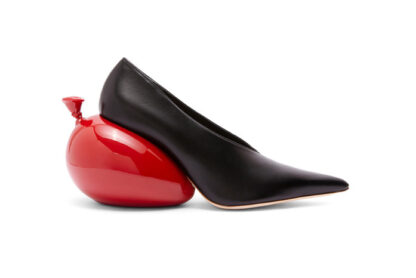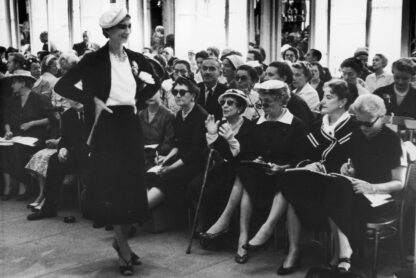Are you curious to learn more about fashion history? These 12 fascinating facts about fashion from the past might surprise you.
Jeans, sneakers, the mini skirt…we all have these pieces in our wardrobes. But do you when and how they originated?
In this article, we uncover the curious origins of some of the basic pieces, along with other fashion facts and trends that existed in the past and left an enduring influence on modern fashion.
Interesting Facts about Fashion
1. The Influence of Sumptuary Laws
The freedom to dress as one sees fit is quite recent. In the past, regulations governing dress and appearance were stringent. They were called “sumptuary laws”.
Dating back to 215 BC, and reinforced in the 12th century, sumptuary laws defined the types, quality, and quantity of items that each social group was allowed to wear. The purpose of these laws was to limit personal expenditures and excess (not only in clothing but also in food, drink, household, and other aspects of daily life), reinforce social hierarchies, and set moral standards. In fashion, particularly, these regulations addressed how the garments were made, decorated, and accessorized. They were drawn up by kings or city officials appointed specifically to control dress.
Of all the countries, Italy was the most prolific in passing sumptuary laws in basically every aspect of daily life. However, other European countries as well, such as England and France, also enacted them. Often, a special register recorded the allowed owner, type of garments, and their specifications.
Although sumptuary laws applied to all social classes, including high-ranking elites, legislation was often particularly strict with individuals of the lower class. They were forbidden to wear the most expensive and prestigious garments made from silk fabrics, as well as ‘noble’ accessories like scented gloves and feathers in hats. Another curious fashion rule was the prohibition of wearing certain colors, such as purple, which was restricted to the upper classes!
Most of the sumptuary laws were passed on religious and moral grounds, and many targeted women. Another reason was to preserve the local economy by restricting the import of textiles and garments from foreign countries.
In most of Europe, sumptuary laws began losing relevance during the 17th and 18th centuries and ceased to exist in most parts of the world in the 19th century. Indeed, economic changes, the development of mercantilism, cultural shifts, and the rise of fashion trends made it increasingly difficult to control consumption patterns. Further, the industrial mass production and the democratization of clothing made sumptuary laws obsolete in most countries.
2. The First Fashion Designer
Before the 19th century, clothing was custom-made by tailors and dressmakers without any singular designer leading trends. That changed with Charles Frederick Worth, an Englishman based in Paris, who is credited as the first fashion designer (in the modern sense of the term) and the inventor of haute couture.
After founding his House of Worth in 1858 at 7 rue de la Paix in Paris, Worth was the first to invite customers to his atelier and recognize and implement a business model based on a single collection. He staged “salon shows” where he showcased designs unique to one collection only. The main goal of these “salon shows” was not so much for art purposes, but mainly to find clients and sell the collection.
Showing his designs live on models at the House of Worth was a first in fashion; his clients could choose a model and select fabrics and colors and had garments tailored according to their preferences and measurements.
Later on, Worth had the idea of organizing events twice a year, so all clients could be in town at the same time and designers could present their different collections, which laid the foundation of Fashion Week. Basically, Worth invented the way the industry runs today and how fashion houses operate and build their collections.
3. The First Designer to Put Labels on Clothing
Surprise: It was also Charles Frederick Worth! Before him, clothes were generally made by anonymous dressmakers, and designs were not attributed to a single person. Worth changed this practice by creating a unique identity for his designs, marking them with his name and signature. They served as a proof of authenticity and protected creations from imitators and copycats.
Thanks to the pioneer Charles Frederick Worth, a designer was no longer seen as just people working behind the scenes; their names became instantly recognizable and associated with specific designs. We can say that Worth made the designers celebrities!
What’s more, Worth is credited with recognizing the importance of branding. By associating his name with high-quality, fashionable clothing, Worth established a brand that was sought after by the elite. By developing the notion of branding, he made the whole fashion industry more important to generate more revenue and stand out from competitors. All this made Charles Frederick Worth a well-reputed couturier in the Parisian couture circles, and one of the most famous in fashion history.
4. The Sewing Machine Revolution
Have you ever thought about who invented the sewing machine?
You might be familiar with famous companies like Singer and Brother, however, these were not the first inventors.
The invention of the sewing machine is attributed to several names in the 18th and the beginning of the 19th century, but the first attempts failed. The first widely recognized sewing machine that turned out to be perfectly functioning was patented by the Frenchman Barthélemy Thimonnier in 1830. His chain stitch sewing machine made of wood received a patent from the French government that year to mass-produce uniforms for the French army.
Thimonnier opened a factory with some 80 sewing machines, but some rioting tailors, who feared that these machines would take away their jobs, destroyed them just a year after their invention.
5. The History of the White Shirt is Linked to a Scandal
Nowadays, the white shirt is an endlessly versatile, affordable, and a must-have piece in every person’s wardrobe. But it wasn’t always like this. The history of the white shirt actually began with a scandal.
The first iteration of the white shirt can be traced back to the 18th century when Marie Antoinette wore a cotton blouse in her portrait from 1783. It was scandalous because the Queen posed with an underwear dress. What’s more, she was wearing cotton, which was a relatively inexpensive and less noble material compared to the finest silks royals wore at the time.
Nonetheless, Marie Antoinette’s portrait had a tremendous impact on making the white shirt an essential piece of a wardrobe. Even though technically it wasn’t a shirt, it was white, light, and made of cotton – a different version of the shirt as we know it today.
In the 19th century, the white shirt was reserved only for men of the upper class. This was the time when the terms ‘white collar’ and ‘blue collar’ originated. The blue collar represented the working class, while the white collar was a symbol of wealth and status.
By the 1920s, however, the white shirt was an increasingly acceptable item to wear for women, who started adopting more relaxed and comfortable silhouettes. The white shirt was increasing in demand, thus, it became more available and affordable. Designers started experimenting with cuts and fabrics, and so the classic shirt with a stiff collar became available in many different styles.
6. Black Was for Mourning Only
Before the 1920s, black clothing was primarily associated with mourning. Queen Victoria’s prolonged mourning period after the death of Prince Albert reinforced this tradition. However, Coco Chanel revolutionized the perception of black with her iconic little black dress. Introduced in 1926 on the pages of Vogue, Mademoiselle Chanel turned black into a fancy color and her little black dress into a symbol of elegance and sophistication.
The design was practical yet elegant indeed. The silhouette was fluid and straight, as opposed to the tight corsets, bustle skirts, and other constrictive clothes that dominated the previous decades. Vogue called the LBD ‘Chanel’s Ford’, meaning it was simple and accessible to women of all classes. Coco Chanel confirmed: “Thanks to me, they [non-wealthy] can walk around like millionaires.”
The Little Black Dress was released in the Great Depression era—a time when simple and affordable designs were key. It remained the perfect outfit choice during the Second World War, which caused severe rationing on textiles because it didn’t need an excessive amount of fabrics to be created.
Since Coco Chanel, the little black dress has been referred to as such and quickly became one of the most influential garments that inspired other designers to reimagine their own versions.
7. The First Sneakers Were Called Plimsolls
The 19th century saw the invention of the first rubber-soled shoes, which were called “plimsolls.” They were called so because the rubber sole resembled the Plimsoll line on a ship’s hull, which indicates maximum safe load. Plimsolls were primarily worn on vacation and for playing sports.
The main difference with today’s shoes is that at the time, there was no distinction between the left and right foot. This changed, however, in 1839, when a man called Charles Goodyear discovered the process of “vulcanization” by figuring out that heating rubber and adding sulfur makes the shoe stronger and more flexible.
These early sneakers set the foundation for modern athletic shoes. In 1886, New Liverpool Rubber Company, the first-ever sneaker company, was born. The 20th century saw the birth of iconic sportswear brands that competed year after year to offer the best sneakers that revolutionized fashion and footwear and have remained iconic pieces on the market until the present day.
8. Where Does Denim Come From?
The origins of denim date back to the late 17th century. It was discovered by weavers in the city of Nîmes in France, hence the wordplay De Nîmes – Denim. They are credited for inventing the first modern denim made of sturdy cotton while trying to replicate the process of producing another popular durable fabric called “serge”.
Around the same time, Italian textile workers in the city of Genoa had been producing a fabric similar to denim made with indigo-dyed wool and cotton and called it “jean” after Genoa. In fact, textiles made during this time were often named based on where they were first manufactured.
As you can see, although nowadays, jeans and denim are interchangeable words, technically speaking, they are two distinctive fabrics and have different etymological roots.
Fast forward to 1853, Levi Strauss founded his namesake company in San Francisco. On May 20, 1873, the blue jeans were born. Together with a tailor named Jacob Davis, they received a U.S. patent for an “Improvement in Fastening Pocket-Openings” by adding metal rivets to work pants, thus making them stronger and more comfortable for working men who did labor-intensive jobs. Known as “waist overalls” until the 1960s, these became the first iteration of what we know today as jeans.
In the early twentieth century, denim was adopted as the preferred material for workwear by western miners, cowboys, farmers, and other blue-collar workers in the United States. It wasn’t until the 1950s that jeans exploded in American culture and were outside of work and for leisure.
9. The Bikini’s Explosive Effect
The history of the bikini can be traced back to Ancient Greek and Roman times. Back in those days, women wore bandeau tops and pants not for swimming or sunbathing at the beach but to participate in sports because they gave freedom of movement. However, officially, the bikini was created in 1946.
Two designers are credited for the invention of the bikini. In May of 1946, Jacques Heim, a French fashion designer, created a minimalist two-piece swimming garment he called the “Atome”, suggesting that the bikini was as small as an atom.
Then, in July 1946, Louis Réard created what he called “the Bikini”. The term was inspired by an atoll in the Marshall Islands that the United States had chosen to target its atomic bombs. “The Atome” and “The Bikini” were seen by both designers as metaphors for the explosion, which was the exact effect the bikini had on fashion and society in the 40s.
Whilst Heim’s garment was the first to be worn on a beach, it was Réard’s bikini that stuck. The design was so provocative in appearance that most models refused to wear it, but it was eventually showcased by a 19-year-old nude dancer, Micheline Bernardini, inside the Molitor swimming pool in Paris.
It was a controversial piece; many people found it scandalous. However, others fell in love with it. It was a symbol of women’s emancipation, which grew after the Second World War. Diana Vreeland, Vogue’s former editor-in-chief, called the bikini “the most important thing since the atom bomb.”
10. The First Modern Bra
During World War I, women were encouraged to stop wearing corsets to conserve metal for the war effort. This shift led to the increased popularity of the bra, as it provided support without the restrictive boning of corsets. This pivotal moment marked the beginning of modern lingerie as we know it today.
There are two main inventors who are credited for designing the modern bra: Herminie Cadolle from France and Mary Phelps Jacobs from New York.
In 1869, Herminie Cadolle created the first official bra by cutting the corset into two parts, known as the Split Corset, with a top to support the breasts and a bottom to shape the waist. This is what it looked like:
Cadolle’s bra was revolutionary because it liberated women’s bodies from the constrictive corsets. However, this bra was still a rare piece and did not suddenly replace the corset because the S-shape silhouette remained popular until the 1910s and required the corset to achieve the cinched-waisted look.
The next inventor who introduced a different version of the bra was the 19-year-old Mary Phelps Jacobs. Fun fact: She created this brassière as a means to avoid wearing her corset to a debutant ball by basically sewing two silk handkerchiefs together.
On November 3, 1914, the United States Patent and Trademark Office officially granted a patent for her so-called “backless brassière”, which she sold to The Warner Brothers Corset Company for $1,500.
During World War I, women were encouraged to stop wearing corsets to conserve metal for the war effort. This shift led to the increased popularity of the bra, as it provided support without the restrictive boning of corsets.Magazines featured the bra on their pages (actually, Vogue began talking about “brassières” already in 1907), and the word was mentioned in the Oxford English Dictionary for the first time. The brassière became the new, fashionable garment, and was promoted as a more stylish and healthy option than the corset. This pivotal moment marked the beginning of modern lingerie as we know it today.
11. The Paper Dress Obsession in the 60s
The ’60s signaled a big turn in fashion hist. The elegant New Looks, the prestige of couture and bespoke garments, and the limited production that had existed before paved the way for fast and affordable fashion. The new generation of consumers with disposable incomes wanted something fun and youthful, which gave birth to a new trend: the paper dress.
The invention of the paper dress is attributed to Scott Paper. In 1966, the American company introduced a simple disposable shift dress made of ‘Dura-Weave’, a cellulose material – a cheap and disposable alternative that had already been used by laboratory and healthcare workers. So these dresses weren’t actually made from paper, but the fact they were designed to be worn only once or twice coined the term “paper dress”.
The original paper dresses were printed in two patterns – one red and one Op Art – with bold, graphic prints that had become so popular during the sixties. Originally, the promo was intended to be a short-lived marketing campaign for the company’s new tableware range. You could get one of the dresses in the post, along with coupons for the tableware range, by sending Scott Paper for just $1.25. Surprisingly (or not,) this peculiar offer became a sensation, with over half a million orders received in less than a year!
This trend is credited for the launching of mass-produced paper fashion. The fashion world embraced these disposable garments and fast-changing trends. Even food companies like KFC and Campbell’s launched their paper dress ads!
It was a hilarious time. This trend was popular because there was no need to wash, dry, iron, or hang up these paper dresses. “Pop it over your head, go out, and toss it in the bin at night” — that was the message. It was easy.
Although it might be hard to resonate with this trend nowadays (despite we still consume fast fashion,) the paper dress was a fashion-forward statement back in the ‘60s. However, by the end of the decade, the consumerist culture wasn’t in vogue anymore, and the paper dress trend was no longer popular.
12. The Invention of the Mini Skirt: An Ongoing Dispute
The invention of the miniskirt is credited to two big fashion designers in the 60s. Some say it was the British Mary Quant; others claim it was the French André Courrèges.
The debate arises mainly because they introduced their miniskirt in the same year, 1964. Mary Quant first displayed it in the windows of her first Bazaar shop. Fun fact: She coined the term “mini” as a reference to the Mini-Minor car introduced in 1959. Around the same time, on the Parisian fashion scene, André Courrèges introduced his Spring 1964 “Moon Girl” collection of mini trapèze dresses and skirts.
Mary Quant once famously dismissed the dispute by saying:“It wasn’t me or Courrèges who invented the miniskirt anyway—it was the girls in the street who did it.” Either way, we agree that they both understood the needs of modern women and their desire for more simple and practical clothes in the era of freedom, social changes, and sexual revolution.
Which fact about fashion surprised you the most, and what others do you know?
Want to learn about other major fashion inventions and other landmark moments in fashion history? We share about them in our newsletter, 365 Days Of Fashion. Sign up here for a special price!









your post is full of informational content, Awesome!